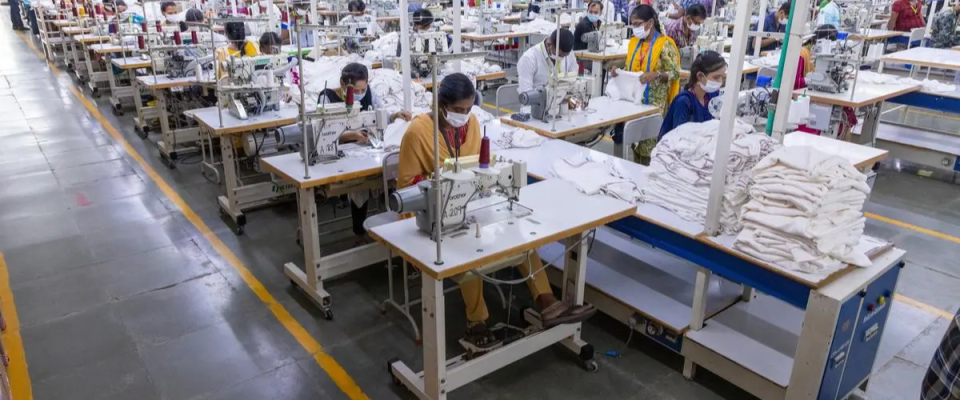The multi-billion-dollar Indian textiles and leather business faces uncertainty following the additional 25 per cent US tariff on India from August 27.
Companies have pushed most of the inventory to the US in the last couple of months to avoid the additional tariffs, but there are still tonnes of garments and leather goods lying in warehouses. There is increasing pressure on Indian companies from customers to share the cost with discounts ranging between 5 per cent and 25 per cent on goods, said sources.
“We will know the impact of this fallout only by the next two weeks as many tried to push deliveries for September by last week,” ” said Thirukkumaran Natarajan, Chairman of Tiruppur-based Esstee Exports India Pvt Ltd. The revenue loss could be ₹1,300 crore to ₹1,500 crore per month for Tiruppur exporters, and ₹4,000 to ₹4,250 crore per month pan-India, he said. Its advantage Bangladesh, Vietnam, Cambodia and Pakistan at much lower tariffs, he added.
When asked why the goods meant for the US cannot be sold in India, he said it is tailor made to the US market with brand name of the brand which cannot be sold in the domestic market. A source said that due to the huge volumes, the US-bound goods cannot be altered and sold in India. The solution now is to negotiate with the customers on discount.
Siddhartha Rajagopal, Director, the Cotton Textiles Export Promotion Council (Texprocil) said while many exporters have shipped the goods in the hope of beating the deadline, some were hoping that the additional tariffs may be deferred and hence were holding on to the merchandise. New orders are on hold as buyers are looking for discounts up to 20-25 per cent and if this trend continues job losses cannot be ruled out.
The 50 per cent reciprocal tariff will literally drive the Indian apparel industry out of the US market, as the 30-31 per cent tariff disadvantage compared to major competing countries is simply unworkable, said Mithileshwar Thakur, Secretary General, Apparel Export Promotion Council. India’s annual exports to the US in FY25 were valued at $86.5 billion, with textiles exports worth $10.3 billion being one of the worst impacted sectors, he added.
Exports to the US fall under three categories — round the year, seasonal trade, and direct trade with brands and buyers. A decision needs to be taken on how to handle requests for discounts on goods subject to higher taxes, instructions to temporarily suspend pending orders, and the cancellation of many orders, said Kumar Duraisamy, Joint Secretary, Tiruppur Exporters’ Association, at an interactive session on the challenges faced by Tiruppur exporters.
The industry is intensifying its efforts towards market diversification, and is looking at every possibility to take advantage of the trade deal with UK and EFTA countries to contain the damage, he said.
According to Rahul Mehta, Chief Mentor at the Clothing Manufacturers Association of India (CMAI) and Director at Creative Group of Companies, “This is a disastrous situation for the industry, especially for exporters dependent on the US. market. At some stage, there will likely be a political resolution, because even for American consumers, paying an additional 50 per cent is not sustainable. Buyers too will weigh their options- it is not easy to suddenly replace a $50 million or $500 million business, so they may choose to absorb part of the cost increase to ensure continuity of supply.”
While large exporters may find ways to cushion the impact, including nearshoring or negotiating with buyers, the real challenge will be for MSMEs, who account for nearly 80 per cent of India’s garment exports to the US. Out of India’s annual $5.5–6 billion apparel exports to the US, $3–3.5 billion worth of orders are currently at stake. For small and mid-sized players, such disruptions could be a severe blow, he said.
Manish Gupta, Deputy Chief Rating Officer, Crisil Ratings, said that post 50 per cent tariffs, Indian exports to the US may be minimal, despite limited capacity of competing nations in value-added garments and lead time taken by big-box retailers in the US to re-align sourcing arrangements. “Overall, we expect the share of the US in India’s RMG exports to fall from 33 per cent last fiscal to 20-25 per cent this fiscal,” he added.
According to Sivaramakrishnan Ganapathi, Vice Chairman and MD, Gokaldas Exports: “We have tried to de-risk our business model by expanding our product range and building manufacturing facilities across continents. We have become more agile, and can quickly add production capacity in favourable locations. We are looking at newer markets to add to our existing mix, which is currently US focused. Recently, we have acquired fabric maker BTPL as a part of backward integration to boost our operating margins. The India-US tariff scenario is an unprecedented event. We will explore all options to hold on to our existing customers, while we simultaneously try to diversify our markets and production locations.”
It’s a similar situation in the leather sector. “We cannot quantify the inventory. But it’s going to be millions of dollars. We have started looking at other markets. Also, we are supporting the customers by sharing the tariffs. They want us to bear 25 per cent, but we are still negotiating how to solve it,” said Sanjay Lulla, Managing Director, SM Lulla Industries Worldwide, which export high fashion leather garments to Europe and the US. “We have not agreed for the discounts. We are finding ways to give lower priced leather and lower cost accessories. We are also looking at other markets such as Russia and Australia, ,” he said.
News Courtesy : The Hindu Business Line.

